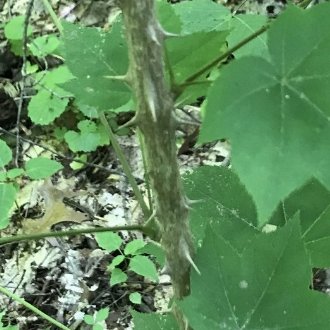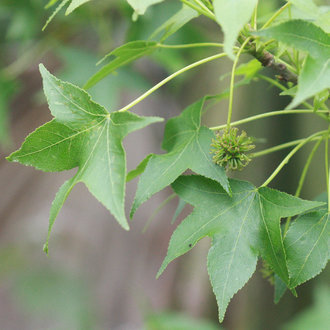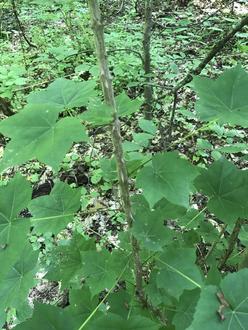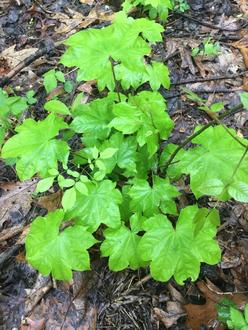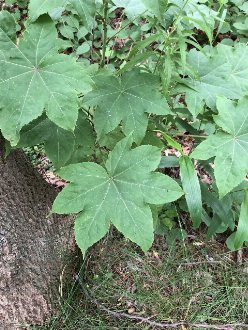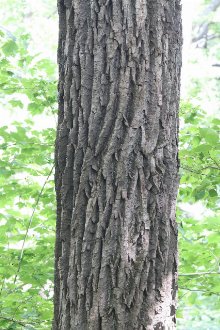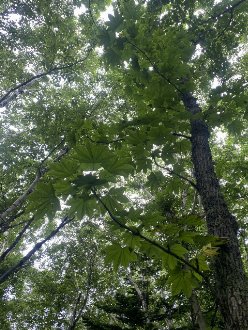Castor-Aralia (Kalopanax septemlobus (Thunb.) Koidz)
Also known as castor aralia, tree aralia, prickly castor oil tree.
↑Summary
An uncommonly cultivated introduced species in North America, someties escaping into the wild; has potential to become invasive, but not widely planted.
↑Description & Identification
A large deciduous tree native to East Asia and introduced in North America, where it shows potential to become an invasive species, but has yet to become widely established, because it is only rarely planted.
↑Similar Plants
↑Habitat
The habitat of this species in North America is not well-known. In Japan, China, Korea, and eastern Russia, it is a dominant canopy tree in cool, moist deciduous forests. Usually found in moist, fertile soils.
This species has been threatened in its native range.
↑Life Cycle
Seed is dispersed by birds, and only germinates after a period of cold-dormancy.
↑Control
This species has high invasive potential in North America, particularly in the northeast and northeastern portion of the Midwest. It is difficult to control once established, due to its ability to invade mature forests, its bird-dispersed seeds which can be carried far from the parent tree, and its persistence in the seed bank.
Because it is so rarely planted, at this point the most important facet of control is to remove as many of the originally-planted trees as possible. An overwhelming majority of the source individuals of this tree for introductions are found in arboretums, botanic gardens, and on the properties of private collectors of exotic plants. Because even a single tree can start a population, it is key that we remove as many of these trees as possible as soon as possible.
This species is currently in a narrow window in which it is possible to still prevent its establishment in the wild in North America and remove it from the areas where it has established in the wild. However, as more time elapses without existing trees being removed, it will become progressively more difficult and labor-intensive to control, to the point where eradication will become practically impossible.
This tree has some resprout potential, but it does not resprout as vigorously or repeatedly as most trees. Usually, cutting down a mature tree and following-up to remove stump sprouts is sufficient for killing it. Stumps or cuts can also be treated with herbicide to prevent resprout.
The harder aspect of control is tracking down offspring of mature trees, which can be found a significant distance from the parent tree. To this end, education and surveying of all wild land, which may involve working with private property owners and/or difficult-to-access forest fragments on industrial land, is often necessary.
Seedlings and small saplings that have not yet reached flowering and fruiting age can usually be uprooted.
This species can form a seed bank, so long-term monitoring of areas in the vicinity of former trees may be necessary to ensure this species does not re-establish.
↑Uses
Used for timber in China, where it is planted for this purpose.
In Korea, this is one of many plants used to make Sukhoe(??); the young shoots are used.
In the U.S., rarely planted as an exotic specimen, mostly in arboretums. We recommend removing it and not planting it, as it has shown high potential to become invasive and the main limiting factor in its invasiveness is probably the fact that it is rarely planted.
↑Related Plants
This species is the only species of its genus. There are, however, numerous other species in the Schefflerieae tribe of the Aralioideae subfamily of the Araliaceae family, to which this species belongs.
In North America, these plants include the introduced plants Eleutherococcus sieboldianus and Eleutherococcus trifoliatus (Eleuthero or Siberian ginsengs), Fatsia japonica, several Hedera sp. (Ivy), and Schefflera sp., Tetrapanax papyriferus.
Devilsclub (Oplopanax horridus) is native to the northwest, but does not overlap with areas where this species has been introduced. It is the closest relative of this species native anywhere in North America.
The broader Aralioideae subfamily contains numerous native and introduced plants.
↑Links & External Resources
• Kalopanax septemlobus (Castor-Aralia) | USDA PLANTS Database (About This Site)
• Kalopanax septemlobus | Go Botany (About This Site)
• Kalopanax septemlobus (Castor Aralia) | Missouri Botanical Garden Plant Finder (About This Site)
• Kalopanax septemlobus | Biota of North America Project (BONAP) (About This Site)
• Kalopanax septemlobus (Thunb.) Koidz. | Plants of the World Online (POWO) (About This Site)
• Kalopanax septemlobus | NatureServe Explorer (About This Site)
• Prickly Castor Oil Tree | Maryland Biodiversity Project (About This Site)
• Kalopanax septemlobus (Thunb. ex A. Murr.) Koidz. (Castor Aralia, Prickly Castor Oil Tree) | Digital Atlas of the Virginia Flora (About This Site)



